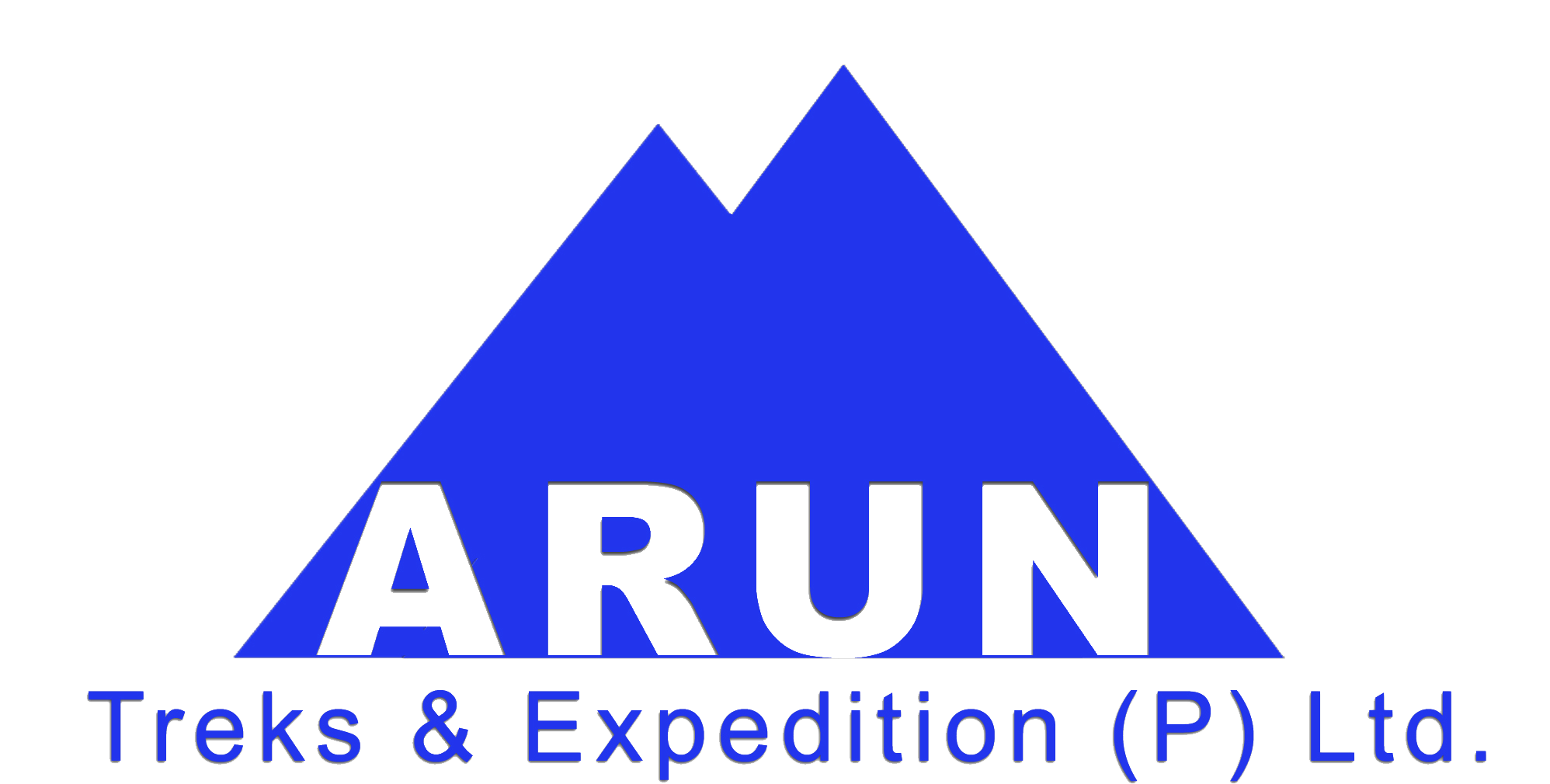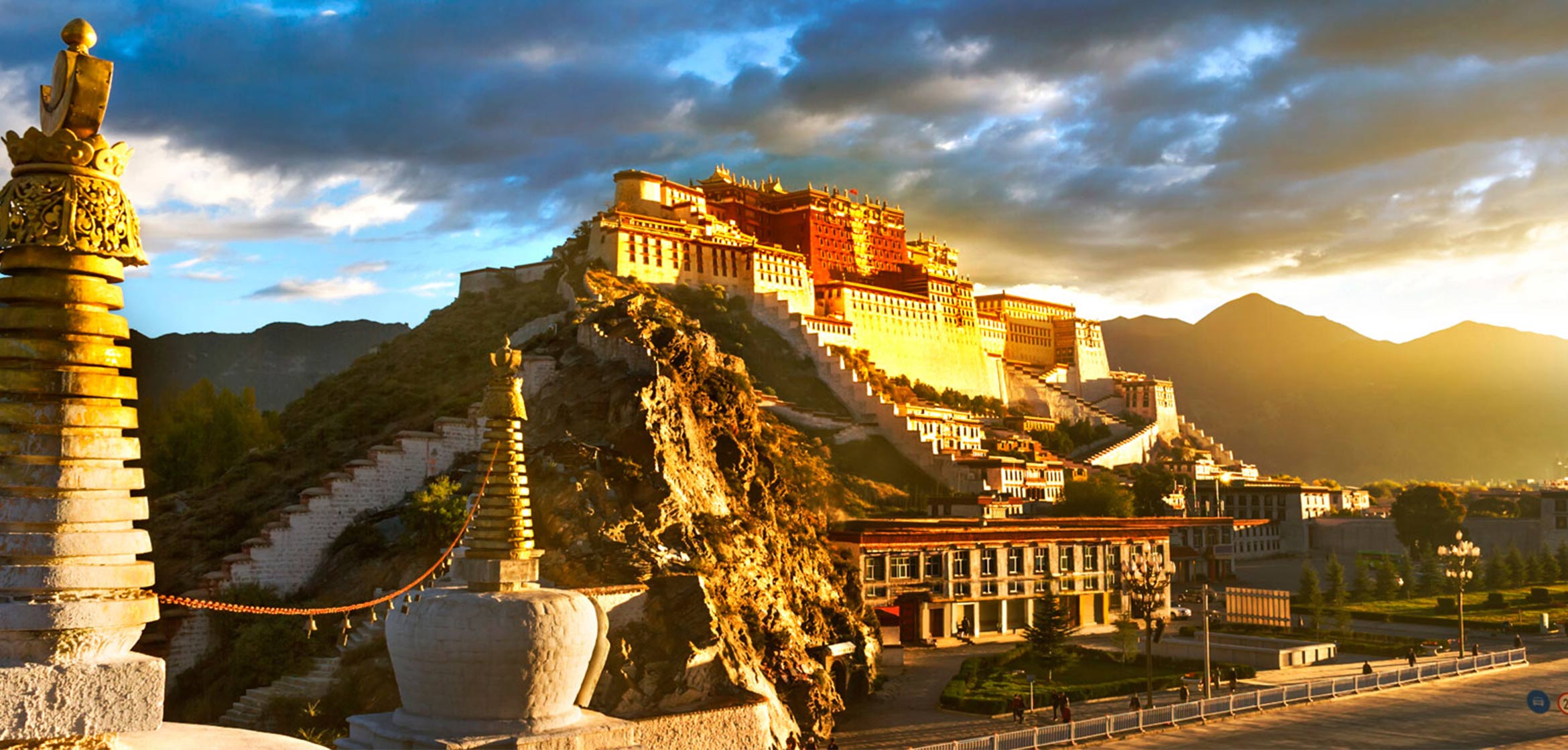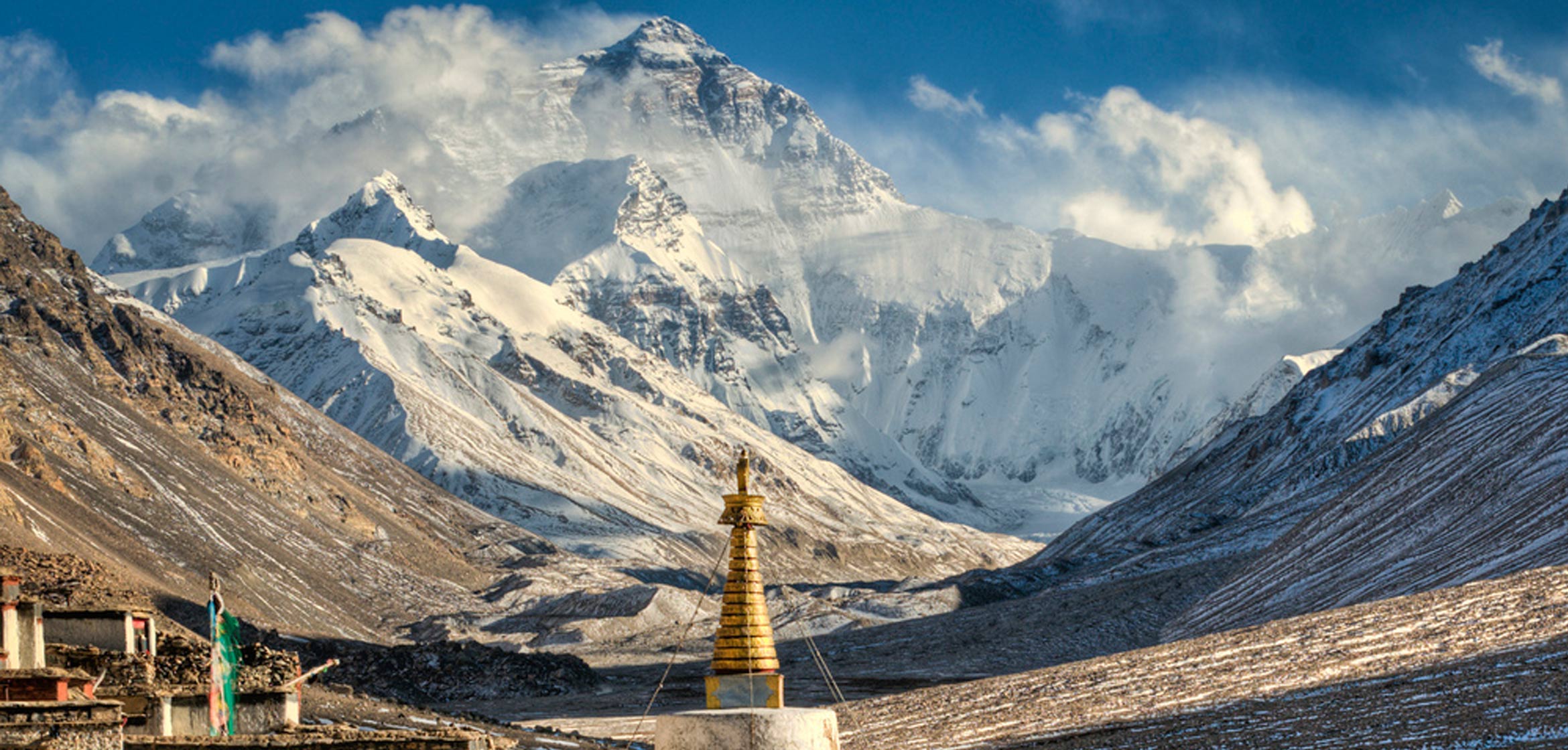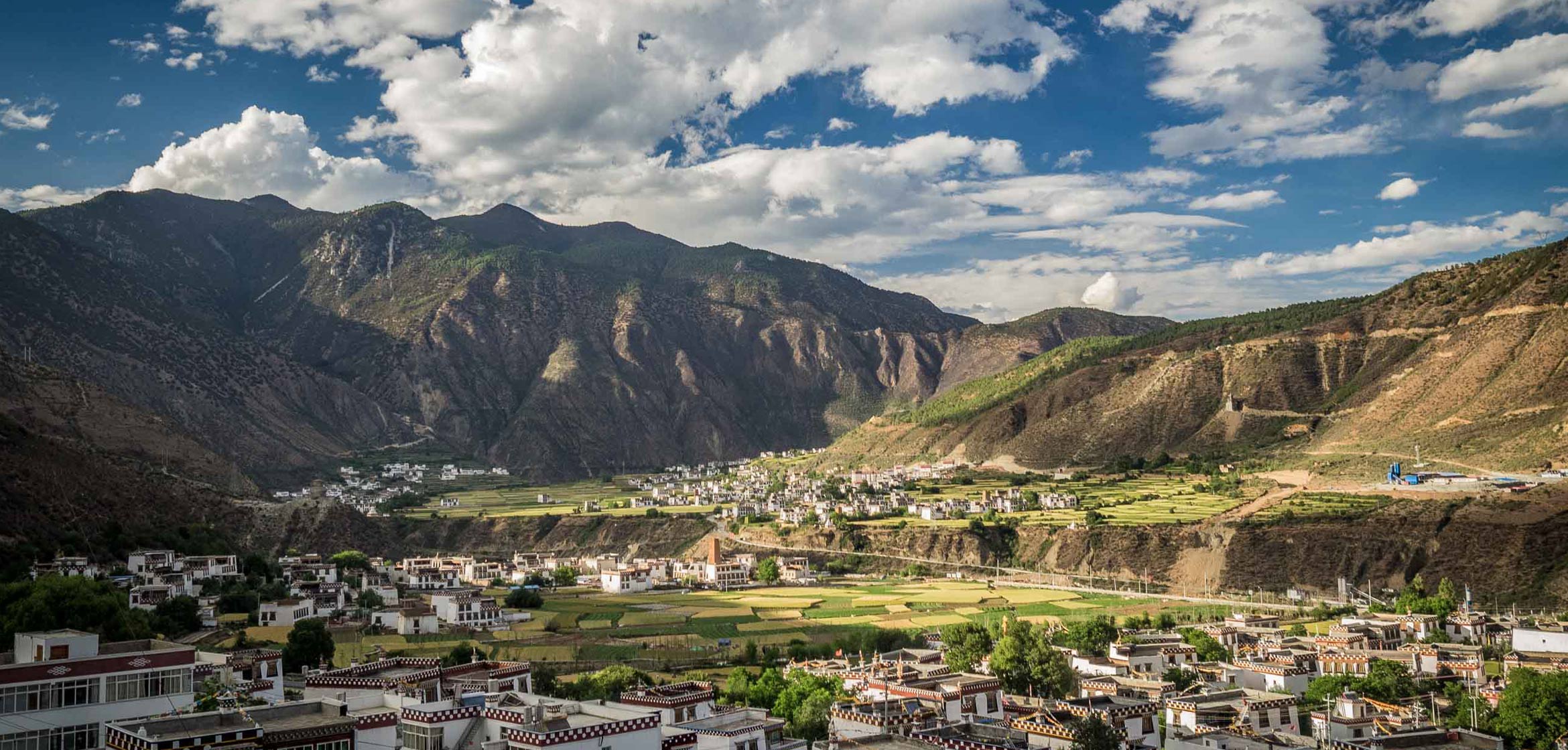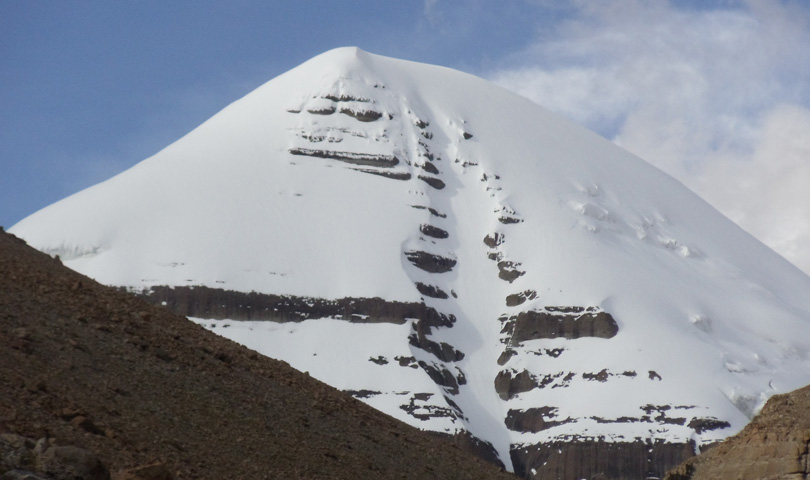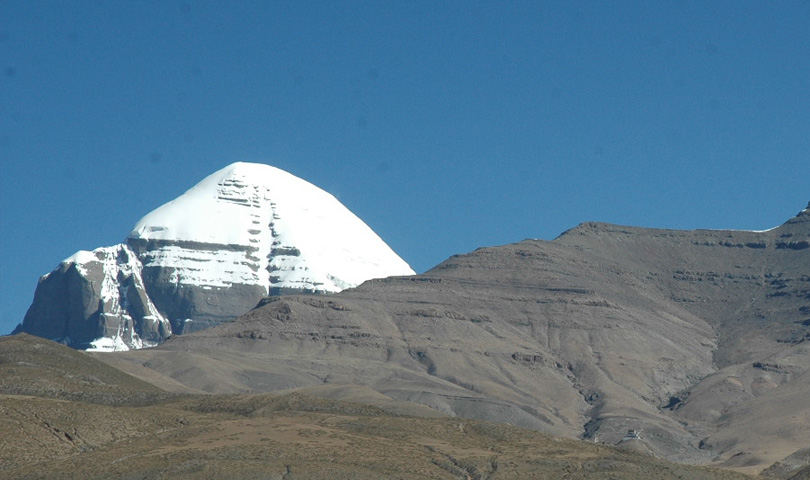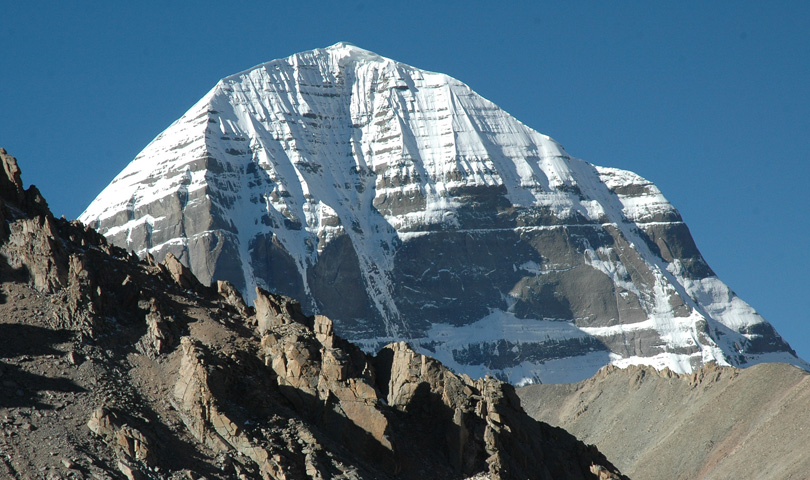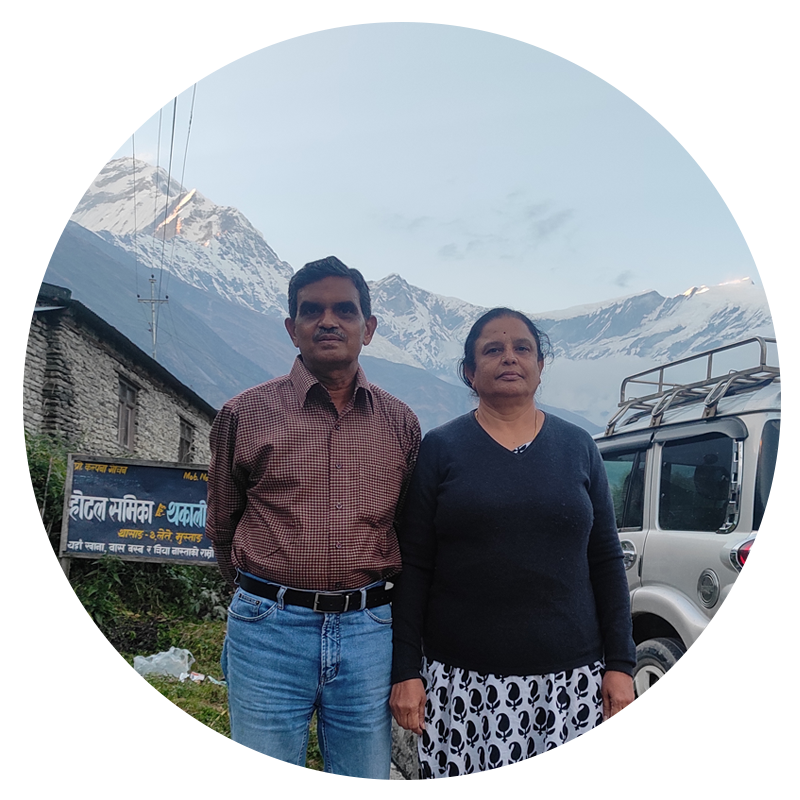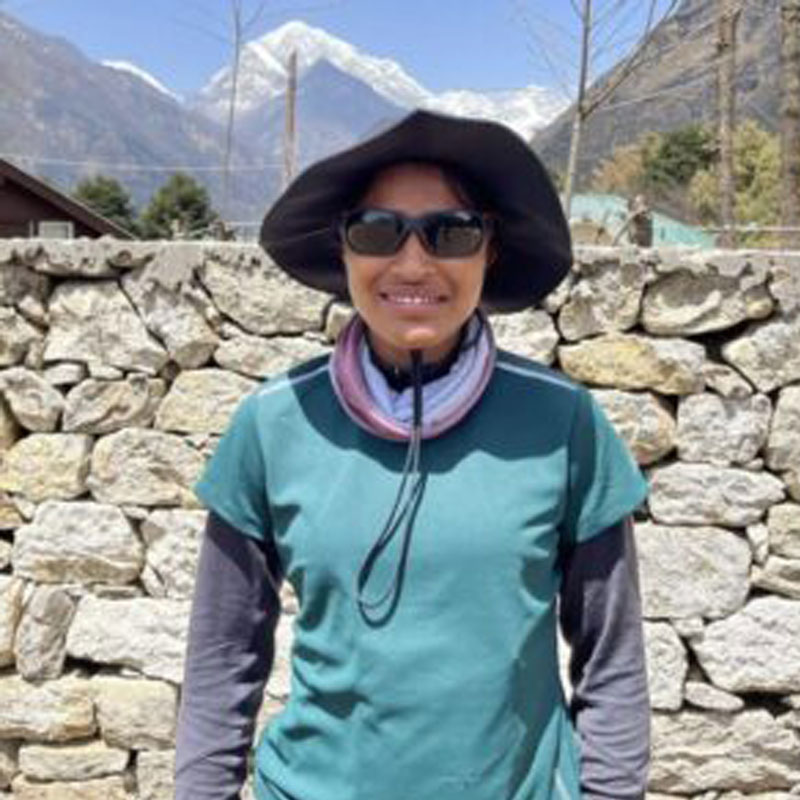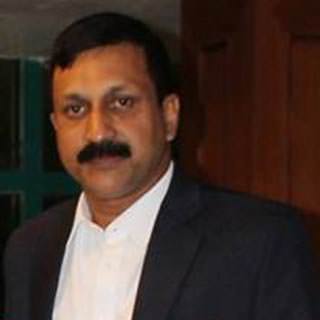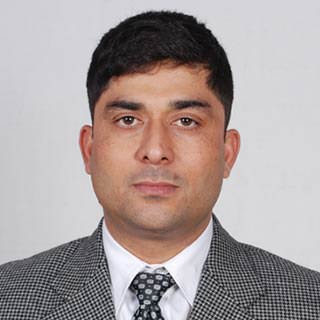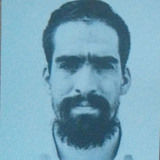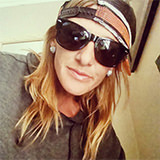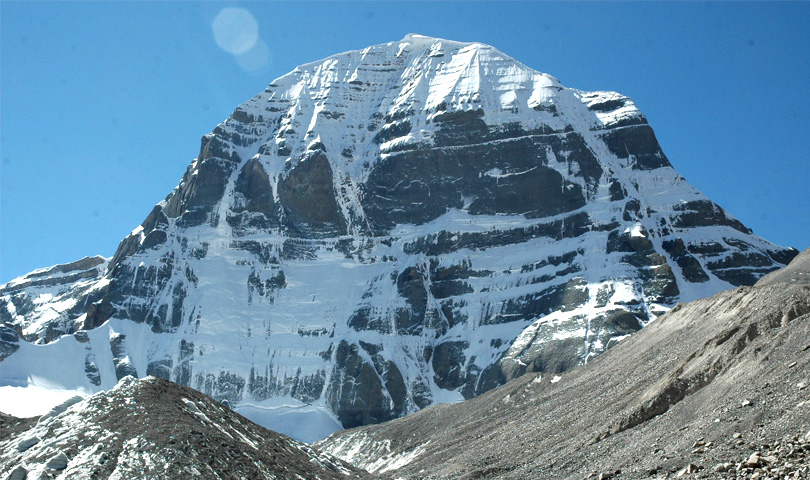
The Himalayan mountain range, formed about 80 million years ago when India broke away from a massive proto continent, has effectively blocked moisture from reaching the Tibetan plateau. This has resulted in the desertification of the once lush and fertile plains. There are three distinct regions in Tibet: Northern plateau, Inter plateau & Southwestern plateau.
Tibet, the buddhist kingdom locked away in its mountain vastness on the himalayas is a unique destination. It is a land of an ancient Buddhist culture, awesome landscapes, artistic monasteries, exotic cities, hidden valleys and centuries-old caravan trials.
This trip to Tibet offers a unique opportunity to visit Lhasa, the epicenter of Tibetan Buddhist religion and rule. Flying from Kathmandu(1,300m) over the spectacular himalayan mountain chain, we’ll arrive just outside Lhasa at almost 3,680m. We’ll spend our first night in Tibet relaxing and acclimatizing to the significant increase in altitude. While in Lhasa, we’ll tour the labyrinthine halls of the former winter residence of the Dalai Lama, the Potala Palace, and his summer residence, Norbulingka Palace, the seat of power over the Tibetan plateau. We’ll visit the largest monastic university in Tibet at Drepung and walk the kora around Jokhang Monastery with time to barter for goods at Barkhor Market, the heart of both trade & religion in Lhasa.
.png) 03 night 04 days(Fly in Fly out)
03 night 04 days(Fly in Fly out)
 Flight to Lhasa (3,680m) Rest/acclimatization; explore; Barkhor square
Flight to Lhasa (3,680m) Rest/acclimatization; explore; Barkhor square
 Guided tour of Potala palace and Drepung monastery.
Guided tour of Potala palace and Drepung monastery.
 Guided tour of Sera monastery & Jokhang monastery. Evening explore Barkhor market
Guided tour of Sera monastery & Jokhang monastery. Evening explore Barkhor market
 Transfer to airport at schedule time, fly back to Kathmandu
Transfer to airport at schedule time, fly back to Kathmandu
 04 nights 05 days(Fly in Fly out)
04 nights 05 days(Fly in Fly out)
 Flight to Lhasa (3,680m) Rest/acclimatization; explore; Barkhor square
Flight to Lhasa (3,680m) Rest/acclimatization; explore; Barkhor square
 Guided tour of Potala palace and Drepung monastery.
Guided tour of Potala palace and Drepung monastery.
 Guided tour of Sera monastery & Jokhang monastery. Evening explore Barkhor market
Guided tour of Sera monastery & Jokhang monastery. Evening explore Barkhor market
 Guided tour to Norbulingka palace, the summer palace of his holiness 14th Dalai Lama
Guided tour to Norbulingka palace, the summer palace of his holiness 14th Dalai Lama
 Early morning transfer to airport at schedule time, fly back to Kathmandu
Early morning transfer to airport at schedule time, fly back to Kathmandu
Tour(01 & 02) includes:
• Necessary permit & entrance fee
• Both way (KTM-Lhasa-KTM) air fares
• Hotel accommodation in Lhasa as per itinerary on BB basis
• Guided tours in Lhasa
• Private transport & necessary monastery entrance fees
• All airport/hotel transfer in KTM & Lhasa
.png)
 07 night 08 days(Fly in Fly out)
07 night 08 days(Fly in Fly out)
 Flight to Lhasa (3,680m). Rest/acclimatization; explore; Barkhor square
Flight to Lhasa (3,680m). Rest/acclimatization; explore; Barkhor square
 Guided tour of Potala palace and Drepung monastery.
Guided tour of Potala palace and Drepung monastery.
 Guided tour of Sera monastery & Jokhang monastery. Evening explore Barkhor market
Guided tour of Sera monastery & Jokhang monastery. Evening explore Barkhor market
 Drive 259km to Gyantse (3900m) via Yamdrok Tso, crossing Kambala pass (4794m) and Korala pass (5020m); explore ancient fortress/ monastery
Drive 259km to Gyantse (3900m) via Yamdrok Tso, crossing Kambala pass (4794m) and Korala pass (5020m); explore ancient fortress/ monastery
 Drive 90km to Shigatse (3860m). En route visit Zhalu monastery, guided tour to Tashilhunpo monastery, Overnight Shigatse.
Drive 90km to Shigatse (3860m). En route visit Zhalu monastery, guided tour to Tashilhunpo monastery, Overnight Shigatse.
 Drive 300km to Tingri (4340m)
Drive 300km to Tingri (4340m)
 Drive 181km to Kyirong/Zangmu.
Drive 181km to Kyirong/Zangmu.
 Cross border into Nepal; drive back to Kathmandu
Cross border into Nepal; drive back to Kathmandu
 09 night 10 days(Fly in Drive out)
09 night 10 days(Fly in Drive out)
• 03 night in Lhasa
• 01 night in Gyantse
• 02 night in Shigatse
• 02 night in Tingri
• 01 night Zangmu/Kyirong
 Flight to Lhasa (3,680m), transfer to hotel
Flight to Lhasa (3,680m), transfer to hotel
 Sightseeing in Potala Palace, Drepung Monastery and Barkhor
Sightseeing in Potala Palace, Drepung Monastery and Barkhor
 Sightseeing in Lhasa, Norbulinka, Sera & Jokhang.
Sightseeing in Lhasa, Norbulinka, Sera & Jokhang.
 Drive 259km to Gyantse (3900m) via Yamdrok lake
Drive 259km to Gyantse (3900m) via Yamdrok lake
 Visit Gyantse (Gyantse Kumbum Stupa & Pekhor monastery), Drive to Salu, and little hike in the area of Salu. Drive 90km to Shigatse
Visit Gyantse (Gyantse Kumbum Stupa & Pekhor monastery), Drive to Salu, and little hike in the area of Salu. Drive 90km to Shigatse
 Morning visit Tashilumpo and Shalu, afternoon Kora around monastery or hike to the holy muntain behind the monastery
Morning visit Tashilumpo and Shalu, afternoon Kora around monastery or hike to the holy muntain behind the monastery
 Drive 300km to Tingri (4340m)
Drive 300km to Tingri (4340m)
 Whole day trip to Rongbuk (4880m), back to Tingri
Whole day trip to Rongbuk (4880m), back to Tingri
 Drive to Zangmu or Kyirong.
Drive to Zangmu or Kyirong.
.png) Cross border into Nepal; drive back to Kathmandu
Cross border into Nepal; drive back to Kathmandu
 10 night 11 days(Fly in Drive out)
10 night 11 days(Fly in Drive out)
• 03 night in Lhasa
• 01 night in Gyantse
• 02 night in Shigatse
• 01 night Shegar
• 01 night Rongbuk
• 01 night in Tingri
• 01 night Zangmu/Kyirong
 Flight to Lhasa (3,680m), transfer to hotel
Flight to Lhasa (3,680m), transfer to hotel
 Sightseeing in Potala Palace, Drepung monastery and Barkhor
Sightseeing in Potala Palace, Drepung monastery and Barkhor
 Sightseeing in Lhasa, Norbulingka, Sera & Jokhang.
Sightseeing in Lhasa, Norbulingka, Sera & Jokhang.
 Drive 259km to Gyantse (3,900m) via Yamdrok Lake
Drive 259km to Gyantse (3,900m) via Yamdrok Lake
 Visit Gyantse (Gyantse Kumbum Stupa & Pekhor monastery), Drive to Salu, and little hike in the area of Salu. Drive 90km to Shigatse
Visit Gyantse (Gyantse Kumbum Stupa & Pekhor monastery), Drive to Salu, and little hike in the area of Salu. Drive 90km to Shigatse
 Morning visit Tashilumpo and Shalu, afternoon Kora around monastery or hike to the holy muntain behind the monastery
Morning visit Tashilumpo and Shalu, afternoon Kora around monastery or hike to the holy muntain behind the monastery
 Drive 244km to Shegar (4,290m)
Drive 244km to Shegar (4,290m)
 Drive 100km to Rongbuk (4880m) and explore the area with Rongphu monastery a highest monastery in the world.
Drive 100km to Rongbuk (4880m) and explore the area with Rongphu monastery a highest monastery in the world.
 Morning explore to Mt. Everest Base Camp (5,040m), after lunch drive 65km Rongbuk to Tingri (4,340m)
Morning explore to Mt. Everest Base Camp (5,040m), after lunch drive 65km Rongbuk to Tingri (4,340m)
.png) Drive to Kyirong or Zangmu.
Drive to Kyirong or Zangmu.
.png) Cross border into Nepal; drive back to Kathmandu
Cross border into Nepal; drive back to Kathmandu
Tour(03, 04 & 05) includes:
• Necessary permit & entrance fee
• One way (KTM-Lhasa) air fares
• Jeep transport during tour
• Hotel accommodation in Lhasa as per itinerary on BB basis
• Guided tours during tour period
• Private transport & necessary monastery entrance fees
• Private transport & necessary custom clearance at China/Nepal border
• All airport/hotel transfer in Kathmandu & Lhasa
The Himalayan mountain range, formed about 80 million years ago when India broke away from a massive proto continent, has effectively blocked moisture from reaching the Tibetan plateau. This has resulted in the desertification of the once lush and fertile plains. There are three distinct regions in Tibet: Northern plateau, Inter plateau & Southwestern plateau.
Tibet, the buddhist kingdom locked away in its mountain vastness on the himalayas is a unique destination. It is a land of an ancient Buddhist culture, awesome landscapes, artistic monasteries, exotic cities, hidden valleys and centuries-old caravan trials.
This trip to Tibet offers a unique opportunity to visit Lhasa, the epicenter of Tibetan Buddhist religion and rule. Flying from Kathmandu(1,300m) over the spectacular himalayan mountain chain, we’ll arrive just outside Lhasa at almost 3,680m. We’ll spend our first night in Tibet relaxing and acclimatizing to the significant increase in altitude. While in Lhasa, we’ll tour the labyrinthine halls of the former winter residence of the Dalai Lama, the Potala Palace, and his summer residence, Norbulingka Palace, the seat of power over the Tibetan plateau. We’ll visit the largest monastic university in Tibet at Drepung and walk the kora around Jokhang Monastery with time to barter for goods at Barkhor Market, the heart of both trade & religion in Lhasa.
| Trip Code | - | ATE-TibetTour |
| Altitude | - | Min- 1,400m to Max 5,020m (as per tour) |
| Grade | - |  |
| Activities | - | Tibet tour |
| Trip Duration | - | - |
| Trip Best Season | - | Autumn/Spring |
| Group Size | - |
 flexible as per request flexible as per request |
| Start/End at | - | Kathmandu/ Kathmandu |
| Destination | - | Tibet |
| Departure Date | - | March/April/May/Oct/Nov/Dec |
| Cost | - | N/A |
| Hotel Info | - | as per request |

• Travel/town clothes (can leave extras in hotel in KTM)
• Sun hat suitable for snow conditions
• Sunglasses: Category 3 or4, glacier type, UV & polarized are best
• Snow goggles (as for skiing)
• Warm (fleece/wool) hat or beanie
• Fleece scarf or neck gaiter AND balaclava
• 1-2 pairs of thermal liner gloves
• Windstopper fleece gloves
• Heavy mitts with waterproof shell (note: mitts not gloves)
• T-shirt/long-sleeved shirt
• 2 Thermal tops
• Fleece jacket or pullover mid weight
• Fleece jacket heavy weight
• INCL Mid-heavy weight down jacket
• Rain and wind-proof jacket, preferably Gore-Tex
• Rain and wind-proof pants (best with full side zips)
• Trekking shorts&/or long pants lightweight
• 1-2 Thermal long pants
• Fleece long pants, mid weight
• Several pair's socks and underwear
• Trekking boots – we suggest strong leather boots
• Warm boots for camp (e.g. sheep skin boots) *Optional but great!
Other Personal Gear
• Sun screen, zinc cream and lip balm
• Wash kit (small personal toiletries, nail clippers and pack towel)
• First aid kit and blister kit
• Personal medicines including your usual medicines
AND 1 course each of (usually available in Kathmandu):
• Respiratory antibiotic (e.g. Amoxycillin)
• Gastrointestinal antibiotic (e.g. Ciprofloxacin)
• Gastro treatment (e.g. Imodium)
• Mild pain killers (e.g. Aspirin/paracetamol/ibuprofen)
• Throat lozenges
• Altitude medication (e.g. Diamox)

Day pack 70L - 85L
• Down suit
• One sport millet shoes
• Water containers: minimum 3L: e.g. Nalgene wide mouth bottles 1L + bottles or bladder another 2L capacity
• INCL Foam sleeping mat
• An extra sleeping mat (*recommended; e.g. Thermo-Rest or Ridge Rest
• 1 Summit down sleeping bag for high camps
• INCL Sleeping bag for base camp and trek use
• Water-proof bag for sleeping bag (e.g. dry bag or robust plastic bag(s))
• Head lamp (we suggest Black Diamond with LED), spare batteries
• Pee bottle — wide mouth Nalgenes are good *Optional
• Crampons Alpine style with rapid-fix bail type to suit your boots (e.g. Black Diamond Sabretooth)
• Gaiters (for snow) appropriate to your plastic & trekking boots
• Adjustable trekking pole(s)
• Ice axe: one only, 65-75cm in length
• Climbing harness with a belay loop, adjustable leg loops
• Belay/Abseiling gear: e.g. Black Diamond ATC
• Ascender e.g. Petzl expedition ascender
• 2 Non-locking carabineers
• 2 Locking carabineers (wide gate preferred)
Group Equipment Supplied
INCL Group medical kit (for altitude illness, trauma, reserve antibiotics); emergency oxygen and portable altitude chamber
INCL Satellite phone (pay for air time used: USD /minute)
INCL Sleeping tents, dining tent, all cooking and eating equipment & food on trek/climb
INCL 240VAC generatorat BC to recharge camera batteries
INCL Barrel or duffle bag for transporting personal gear by Yak and truck
INCL Climbing ropes, fixed safety ropes
INCL Snow anchors, ice anchors, rock anchors, v-thread cord
NOTE: You must have all of the above personal gear, clothing and equipment. It may be possible to buy some extra equipment (If forgotten) but don't rely on it.
R: This item is available to rent
INCL: This item included in package
*Note* :- May be change/replace as per tour
Arun Trek's trip web pages, and pdf info packs have lots of info about each specific adventure (search for your adventure here). You may also like to look at our photo galleries or videos for a taste of adventure, or download a wallpaper to inspire you at your computer. This page has answers to some more general Frequently Asked Questions (FAQS) about climbing.
As all of our mountain climbing adventures begin with a trek, you might also like to look at the Trekking FAQs.
If you have other questions, please ask our friendly team, by email, phone, and skype.
Q) Can I really climb a mountain? Do I need to have climbing experience? How can I climb Mount Everest? Can I climb the seven summits?
A) The level of experience and skills required depends on your particular goal (search for your adventure here). We suggest that people undertaking a first climb should have had at least overnight trekking experience. For those who wish to take on a technically difficult, remote or extreme altitude mountain we'd expect participants to have appropriate experience and skills. Some ideas for preparing for climbing goals are given at the bottom of this page.
Q) Why go on a guided expedition?
A) There are many reasons that might make a guided expedition attractive even for experienced climbers. These include someone else taking care of all those details (including thing as diverse as booking and confirming hotels, checking the number of evening snacks, ensuring reliable support, transport, permits, visas, team members, gear, etc etc etc etc). This saves your time and energy for the part that really matters - working on achieving your goal. The high levels of support and experience aim to give you the best possible opportunity to succeed, a high level of risk management, and the Arun leaders and staff are there for YOU!
Q) What type of people comes along?
A) Climbing expeditions usually attract people in their twenties to fifties. Participants tend to be seeking a good quality, safe, well supported, good value and enjoyable adventure rather than the lowest cost.
Q) How fit do I need to be? Will I have to carry a lot of weight? Should I be able to do 100 chin ups?
A) The fitter you are, the more fun you (and your companions) will have. You will find guidance on preparing for your expedition on each adventure's web page (search here), our info packs and trip dossiers. A minimum level of fitness would have you being able to walk all day on uneven, hilly ground, carrying your day pack, and be able to get up again the next day. Many climbs will require a higher level of fitness and strength so you can carry heavy gear to high camps and really exert yourself on summit day.
Q) What gear is provided?
A) Included are individual sleeping tents for the trekking phase of most climbing expeditions, with dining and kitchen tents. On the mountain participants share serious, proven mountain tents. Climbing teams are equipped with emergency communications and first aid equipment as well as more prosaic things like climbing and cooking gear. There is a detailed gear list for each adventure which outlines what we provide as well as what you should bring. (Search here for specific adventures and download the info pack.)
Q) What's the food like?
A) Food arrangements are specific to each adventure, but you get three meals a day while on the track. In cities included is breakfast and, depending on the trip and the nature of the activities may also cater for lunch and dinner for the group. In the Himalayas the kitchen staffs have been training for years and work magic over gas or kero stoves in their kitchen tent.
While trekking the cooks prepare a varied menu of wholesome, tasty and plentiful food using fresh ingredients where possible. A trekking breakfast in the Himalayas usually includes cooked foods e.g. eggs, tomatoes, cereal or porridge, toast & spreads and fruit and a selection of hot drinks.
Lunch is often soup and a packed lunch, or a cooked lunch. Dinners are generally soup, a main meal (one of many Asian or European style dishes) veges, and a dessert (fruit to custard to baked apple pie!) Drinking water: will be provided at camps (collected with care, filtered, treated with chemicals and/or boiled), and at lunch time where possible. It is wise to carry a small amount of purifying chemicals (e.g. Iodine or chlorine) with you, in case you happen to need water at an odd time. In the developing world care should be taken to avoid untreated water and potentially contaminated foods like uncooked salads and some fruit. Bottled water is available in cities, but of course you can treat tap water in your own bottle too.
On the hill we eat easy to prepare food, often prepared by the team with assistance from guides and staff: freeze-dried foods, crackers, soups, snacks etc. On big mountains it is often a challenge to eat, so we provide foods to tempt your appetite and give you sustenance.
Q) Who will be responsible for my safety?
A) The short answer - you! All participants are expected to behave in a responsible manner, taking due care of themselves and others. Your expedition leader is responsible for the group including participants and staff. He or she will advise, manage and assist everyone, sometimes with the support of an expedition first aider or doctor, and will be assisted by guides, sherpas, and you and your climbing colleagues, all of whom will have roles to play.
Q) What if I get sick or have an accident?
A) Despite the best precautions, people do sometimes fall ill, sprain something or develop symptoms of AMS. Our expedition leaders will manage your care keeping in mind what's best for you and the rest of the group. Precautions include first aid qualifications and kits, emergency communications, evacuation plans, your travel insurance cover and our pre-preparation and medical advisors.
Q) What about altitude sickness?
A) AMS Acute Mountain Sickness (or altitude sickness) is the body reacting to the stress of high altitude. It is a concern for trekkers in the Himalayas and elsewhere above about approximately; say (is that enough vagueness!) 3,000m. Exposure to high altitude can lead to a number of 'normal' physiological reactions as well as mild to extremely serious illness and even death. The treks are designed with relatively slow acclimatisation schedules, rest days and alternative options. And there are medications and a number of management strategies in place should they be required. Don't be unduly concerned, but please talk to us if you have questions.
Q) I don't have much time, can't we do it quicker?
A) The adventures are designed around what we feel is the optimum itinerary, which incorporates adequate time for the suitably fit participant to do the climb comfortably; flexibility for weather, illness, unforeseen delays; time to enjoy the experience, your climbing colleagues and staff; learn about your surroundings if you wish; and, for altitude adventures, a fairly slow acclimatisation regime to minimise the risk of altitude sickness and maximise your chance of reaching your goals. All while also trying to minimise your time away from home. We would generally not recommend shorter itineraries (such as those used by less scrupulous operators) unless you were genuinely prepared to turn back if you (or your travel companion) becomes affected by AMS. If you really don't have the time available, we can perhaps suggest an alternative itinerary or goal that will work for you.
Q) My friend would like to visit, but isn't really interested in climbing...
A) Your friend, spouse, family, colleagues may like to join you on the trekking phases of the expedition, and could stay in Base Camp or Advanced Base Camp, depending on the trip, when you are on the hill. If they want to accompany you to our base city (e.g. Kathmandu) we can easily arrange extra accommodation, and places on our day tours, but we may also be able to arrange a series of day trips, a short relaxing trip into the country-side, scenic flights above the Himalayas, wildlife safaris and so on. Ask us for ideas, or suggest your own.




